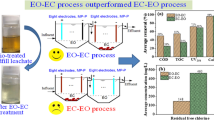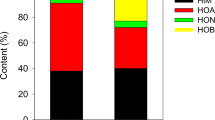Abstract
Landfill leachate treated with combined process of “pretreatment +biological treatment +advanced treatment (NF)” to produce nanofiltration concentrate, which bio-chemical ratio (B/C) is less than 0.1 and CODcr concentration is 2 000–2 500 mg/L, high salt content. Which cannot be discharged under existing environmental standards. According to analysis based on electrochemical advanced oxidation mechanism, a two-step electrochemical technique was recommended. In the first step, a pulse electrochemical technique was adopted. With Fe as consumption electrode and current density of 10 mA/cm2, the pollutants were removed by means of Fenton reaction, electroflotation and electrocoagulation. In the second step, a double function electrode was used to perform electrocatalytic oxidation by means of titanium metallic oxidates. In the condition that current density being 12.5 mA/cm2, the pollutants were further removed by oxidation and electrolytic deposition. Result shows that the removing rate of CODcr, NH3-N and Cl- were 70%–85%, 90% and 25%, respectively; average value of B/C ratio increased from 0.09 to 0.38 and conductivity reduced by 10%.
Similar content being viewed by others
References
Bie R S, Song X F, Ji X Y, et al. Current situation of garbage disposal and policy in foreign and domestic [J]. China Resources Comprehensive Utilization, 2013, 9:31–35 (Ch).
General Office of the State Council. Notice Issued by the State Council General Office on the 12th Five-year, the Whole Nation Urban Life Refuses Disposal Facilities Construction Planning [EB/OL]. [2013-10-19]. http://www.gdepi.com.cn/bencandy.php?fid=92&id=10176
Lei Y M, Shen Z M, Wu D, et al. Water content investigation and treatment countermeasure analysis on shanghai domestic waste [EB/OL]. [2011-03-19]. http://www.cn-hw.net/html/32/201103/26314_2.html.
Environmental Protection Department. Leachate Treatment Project Technical Specification of Municipal Solid Waste Landfill(HJ564-2010)[S]. Beijing: China Environmental Science Press, 2010(Ch).
Chen J. Treatment of strong sewage from refuse with mineralized garbage[J]. Enviornmental Science and Management, 2007, 32: 109–112(Ch).
Zhong J. Techniques overview of concentration liquid treatment in leachate membrane filtration[J]. Guangdong Chemical Industry, 2011, 38(8): 264–265(Ch).
Zhou J. Discussion on treatment technology of landfill leachate membrane filtration concentrate [J]. Henan Chemical Industry, 2010, 2(27): 55–56(Ch).
Jiang B J, Li J S, Yang W, et al. Study on pilot experiment of recirculation treatment of concentrated liquor produced by leachate reverse-osmosis [J]. Journal of Harbin University of Commerce(Natural Sciences Edition), 2006, 6(22): 36–39(Ch).
Yang Q, He J J, Shao L M. Vacuum evaporation method in the treatment of Landfill Leachate [J]. Environmental Engineering, 2006, 21(2): 17–19(Ch).
Xu S S. Research on UV-Fenton Treatment of Concentrated Water from Nanofiltration of Landfill Leachate [D]. Beijing: Tsinghua University, 2012(Ch).
Wei X Y, Xia P F, Li A Z, et al. Treatment of biotreated leachate nanofiltration reject by enhanced coagulation and photoelectro-oxidation process [J]. Chinese Journal of Environmental Engineering, 2012, 9(6): 3040–3046(Ch).
Top S, Sekman E, Hosver S, et al. Characterization and electrocaogulative treatment of nanofiltration concentrate of a full-scale landfill leachate treatment plant [J]. Desalination, 2011, 268(1–3): 158–162.
Liu D L, Huang Y B. Hydroxide free radical: Its formation and application in water treatment [J]. Environmental Science & Technology, 2003, 26(2): 44–46(Ch).
The State Environmental Protection Department, Water and Wastewater Analysis Method Editorial Board. Water and Wastewater Analysis Methods [M]. Beijing: China Environmental Science Press, 2002(Ch).
Chen X M, Chen G H, Po Lock Yue.Separation of pollutants from restaurant wastewater by electrocoagulation[J]. Separation and Purification Technology, 2000, 19: 65–76.
Chen J L, Shi H C, Xu L L. Effect of pH for the electrochemical oxidation products and oxidation pathways of ammonia [J]. Environmental Science, 2008, 8(29): 2277–2281(Ch).
Author information
Authors and Affiliations
Corresponding author
Additional information
Biography: XIONG Changgui, male, Professor, Master, research direction: water and wastewater treatment on technical research, engineering consultation and design.
Rights and permissions
About this article
Cite this article
Xiong, C., Li, G., Zhang, Z. et al. Technique for advanced electrochemical oxidation treatment of nanofiltration concentrate of landfill leachate. Wuhan Univ. J. Nat. Sci. 19, 355–360 (2014). https://doi.org/10.1007/s11859-014-1025-1
Received:
Published:
Issue Date:
DOI: https://doi.org/10.1007/s11859-014-1025-1
Key words
- nanofiltration concentrate of landfill leachate
- electrochemistry
- advanced oxidation
- pulse
- electrode
- pollutants




